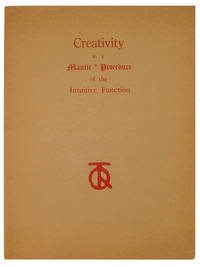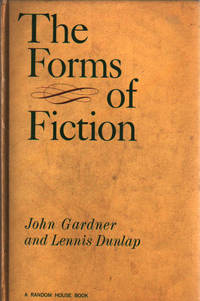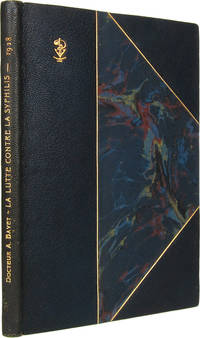
CREATIVITY AS A MANTIC PROCEDURE OF THE INTUITIVE FUNCTION
by [Tyler, Richard Oviet]
- Used
- near fine
- Paperback
- first
- Condition
- Near fine
- Seller
-
Brooklyn, New York, United States
Payment Methods Accepted
About This Item
New York: Hand Set & Printed by Michael Martin & David Lewis, apprentices at Uranian Press N.Y.C., 1960. Bifolium, [4] pp., with 2 inserted leaves (printed rectos only), all 12 x 9 inches, printed in red and black on brown paper. Light wear at edges, 1 3/4- inch crease in outer edge of first leaf, else near fine.
The existential manifesto of the Uranian Press, presenting the original basis of Tyler's integrative vision of art, life, creativity, and journeys through forms of consciousness. Its main text, printed in three pages on a bifolium, is supplemented with two broadside inserts, one of which introduces the manifesto:
In this this paper Creativity is to be understood in the sense of a Self Documented life work toward a more fully integrated individual, able to bridge consciousness between these states, & impart the result in a symbol system seeking to evolve self transcendence to the point of holding in consciousness the knowledge of unity with the universe.
From his decision to leave Chicago in 1958 to his final years conducting underground tattoo and burial ceremonies under the aegises of the Uranian Phalanstery and the First New York Gnostic Lyceum Temple, Tyler was committed to the vision outlined in this document. He also increasingly came to know the "very real dangers" with which "exploration of this dark & terrible, spaceless primordial realm is fraught." He warns in both CREATIVITY's main text and a second broadside insert about these risks: demon possession, "the nihilistic necromancer becom[ing] the False Magician," the "Yang & Yin balance of Violent, vandalistic, nihilistic, Murderous destruction."
Stefan Brecht, who dedicates a chapter of his history of the Bread and Puppet Theater to Tyler, suggests that Tyler ultimately succumbed to those dangers, casting him as both an influence on and a kind of antithesis to Bread and Puppets founder, Peter Schumann. In their early acquaintance, the two had both seen "the threat of nuclear war as crucial, contemporary fact, saw it as a symptom of the preponderant form of madness, rational madness, and saw as only salvation a mass transformation of consciousness from the intellectual to the intuitive" (Brecht, p. 68). Whereas Schumanns "sacrifice of consciousness," however, called on radical love traditions and archetypes from Christian sources, leading him to become a major, transformative player in the peace movement, Brecht contends that Tyler's art was stuck in the sacrifice alone the "mission is reported on, not any achievement of it" (p. 66).
Peter Schumann's son, Max Schumann, himself remembers Tyler as "part genius, part madman" and has long been engaged with his art and philosophy, recently curating the first major retrospective of Tylers work, The Schizophrenic Bomb, at Printed Matter. He contrasts Tyler's work not with Bread and Puppet's but with the commercial gallery culture surrounding Tyler on one hand and insipid New Age movements that emerged around him, using similar symbolic systems, on the other. Tyler defied them all to the end, "not only not being engaged or aspiring to high art or the institutions of arts just completely not recognizing the values" and remaining fully committed to an integrated "art-life practice" that never yielded its "dark, death current" to facile spiritual formulas (Lynch, 2017).
A rare and significant document in postwar psychic exploration and American antiestablishment art.
OCLC records two copies, at Northwestern and the Harry Ransom Center.
Sources: Dennis Lynch, "Rolling Out a Slice of Village Art Psychedelia," in THE VILLAGER, April 6, 2017.
Reviews
(Log in or Create an Account first!)
Details
- Bookseller
- W. C. Baker Rare Books & Ephemera
(US)
- Bookseller's Inventory #
- 711
- Title
- CREATIVITY AS A MANTIC PROCEDURE OF THE INTUITIVE FUNCTION
- Author
- [Tyler, Richard Oviet]
- Format/Binding
- Softcover
- Book Condition
- Used - Near fine
- Quantity Available
- 1
- Edition
- First Edition
- Binding
- Paperback
- Publisher
- Hand Set & Printed by Michael Martin & David Lewis, apprentices at Uranian Press N.Y.C.
- Place of Publication
- New York
- Date Published
- 1960
- Weight
- 0.00 lbs
- Keywords
- American literature, art, modern art, avant garde, psychology, religion, mythology, Jung, New York, Greenwich Village, Lower East Side, East Village, ephemera, broadside
- Bookseller catalogs
- Religion; Social Movements;
Terms of Sale
W. C. Baker Rare Books & Ephemera
7 day return guarantee, with full refund including original shipping costs for up to 7 days after delivery if an item arrives misdescribed or damaged. Items must be returned in the same condition in which they were received.
About the Seller
W. C. Baker Rare Books & Ephemera
About W. C. Baker Rare Books & Ephemera
Glossary
Some terminology that may be used in this description includes:
- New
- A new book is a book previously not circulated to a buyer. Although a new book is typically free of any faults or defects, "new"...
- Leaves
- Very generally, "leaves" refers to the pages of a book, as in the common phrase, "loose-leaf pages." A leaf is a single sheet...
- Fine
- A book in fine condition exhibits no flaws. A fine condition book closely approaches As New condition, but may lack the...
- Edges
- The collective of the top, fore and bottom edges of the text block of the book, being that part of the edges of the pages of a...
Frequently asked questions
This Book’s Categories
Also Recommended
-

Save 10% on every purchase!
Join the Bibliophiles’ Club and start saving 10% on every book.
$29.95 / Year





